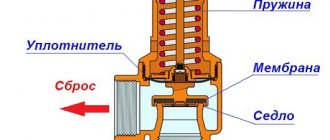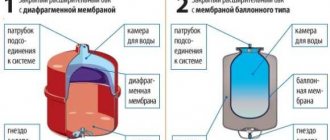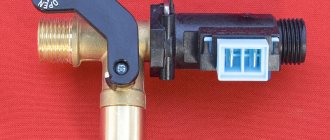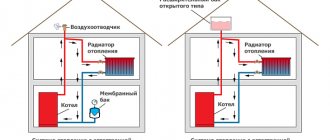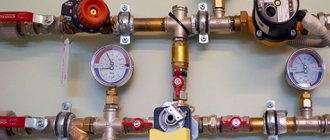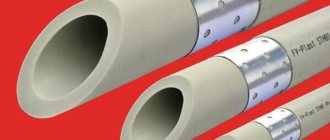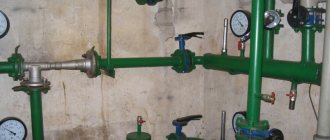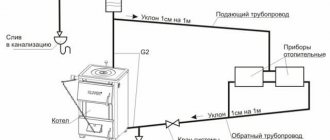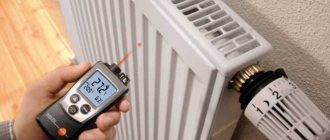Home / Heating
Back
Published: 02/25/2020
Reading time: 5 min
0
8910
The expansion tank in the heating system is designed to compensate for pressure drops in the coolant liquid that occur during starts and stops of the heating network. This phenomenon is explained by the thermal expansion of water or another coolant - antifreeze.
In order to perform its functions, the internal cavity of such a protective device is divided into 2 parts by a membrane - air and water.
The first has preset pressure parameters, which may drop during operation, so the user needs to know how to pump up pressure in the expansion tank of the boiler.
- 1 Design and purpose of the expansion tank
- 2 Correct pressure in the expansion tank 2.1 Norm for different models
- 5.1 Other troubleshooting methods
Why is an expansion tank needed?
During the heating process, water tends to expand - as the temperature rises, the volume of the liquid increases. Pressure begins to increase in the heating system circuit, which can have a destructive effect on gas equipment and the integrity of the pipes.
The expansion tank (expanzomat) serves as an additional reservoir into which excess water formed as a result of heating is pressed out. When the liquid cools and the pressure stabilizes, it returns through the pipes back into the system.
The expansion tank acts as a protective buffer; it dampens water hammer, which constantly forms in the heating system due to frequent turning on and off of the pump, and also eliminates the possibility of air locks.
To reduce the likelihood of air locks and prevent damage to the gas boiler due to water hammer, the expansion tank should be mounted in front of the heat generator, on the return line
There are two different types of damper tanks: open and closed types. They differ not only in design, but also in the method and location of installation. Let's look at the features of each of these types in more detail.
Open expansion tank
An open type tank is mounted at the top point of the heating system. The containers are made of steel. Most often they have a rectangular or cylindrical shape.
Typically, such expansion tanks are installed in the attic or attic. Installation under the roof is possible. It is imperative to pay attention to the thermal insulation of the structure
The structure of the open-type tank has several outlets: for water inlet, cooled liquid outlet, control pipe inlet, and also an outlet pipe for coolant discharge into the sewer. We wrote more about the structure and types of an open tank in our other article.
Open tank functions:
- controls the coolant level in the heating circuit;
- if the temperature in the system has decreased, it compensates for the volume of coolant;
- when the pressure in the system changes, the tank acts as a buffer zone;
- removes excess coolant from the system into the sewer system;
- removes air from the circuit.
Despite the functionality of open expansion tanks, they are practically not used anymore. Since they have many disadvantages, for example, the large size of the container, the tendency to corrosion. They are installed in heating systems that operate only with natural water circulation.
Closed expansion chamber
In closed-circuit heating systems, a membrane-type expansion tank is usually installed; it is optimally suited for any type of gas boiler and has many advantages.
An expansomat is a hermetic container, which is divided in the middle by an elastic membrane. The first half will contain excess water, and the second half will contain regular air or nitrogen.
Closed expansion tanks for heating are usually painted red. There is a membrane inside the tank; it is made of rubber. A necessary element to maintain pressure in the expansion tank
Compensation tanks with a membrane can be produced in the form of a hemisphere or in the form of a cylinder. Which is quite suitable for use in a heating system with a gas boiler. We recommend that you familiarize yourself in more detail with the installation features of closed tanks.
Advantages of membrane types of tanks:
- ease of self-installation;
- corrosion resistance;
- work without regular addition of coolant;
- lack of contact of water with air;
- performance under high load conditions;
- tightness.
Gas attachments are usually equipped with an expansion tank. But the additional tank is not always configured correctly from the factory and can immediately start heating.
How to properly pump up the expansion tank in a boiler
Today I want to talk about what a closed expansion tank is, how it works, what it is needed for, how to choose the right expansion tank, what air pressure needs to be maintained in it and how to inflate it correctly. If you are interested, then listen further.
The design of a closed expansion tank is very simple - it is a container, most often steel, divided inside by an elastic diaphragm. On one side of the diaphragm there is water in working condition, on the other there is air. Instead of a diaphragm, something like a rubber bulb or “balloon” placed inside a steel container can be used. A connecting fitting with a thread with a diameter of 3/8, ½, ¾ or 1 inch and others is welded into the part that is filled with water. In the part where the air is located, there is a built-in fitting with a regular car nipple for filling with air. The shape of the tank can be different - cylindrical in the form of a small barrel, it can be rectangular or round. It depends on where you need to install this expansion tank. There are tanks with legs for installation on the floor, and for hanging on a wall or inside a boiler or other equipment.
Now let's figure out why an expansion tank is needed and where they are installed. They are installed in heating and water supply systems.
In a heating system, an expansion tank is needed to compensate for the thermal expansion of water or other coolant poured into the system. As we all know, liquid is an incompressible medium that has the property of changing its volume depending on temperature. To put it simply, the same amount of liquid at different temperatures occupies different volumes. Most modern heating systems are closed, that is, they have no connection with the atmosphere, and have a certain volume that does not change. If an expansion tank is not installed in the system, or it is selected incorrectly, then when the heating is heated, the liquid will have nowhere to expand and the pressure will rise to a critical value, after which the coolant will be discharged through the emergency relief valve in the system. After turning off the boiler and cooling, the pressure, on the contrary, will drop to zero, the pressure sensor will work and to put the boiler into operation, you will have to replenish the system with water again.
Often, when installing a boiler, people do not think about whether the volume of the built-in expansion tank is sufficient for the normal operation of the heating system, and then they have to deal with the negative consequences of such carelessness. So how to choose the right expansion tank? If you make a calculation, you need to know such parameters as the minimum and maximum heating temperatures and the maximum pressure values in the heating system, the expansion coefficient of the filled coolant. The formula can be found in open sources. But there is one simple rule - the larger the volume of the expansion tank, the less the pressure will change when the temperature changes. That is, “the more,” “the better,” J within reasonable limits, of course. You need to focus on the following figure - the volume of the expansion tank must be at least 10% of the volume of coolant in the system. That is, if 100 liters of water are poured into the heating system, the minimum volume of the expansion tank for normal operation should be 10 liters. Calculating the volume is not difficult. The technical characteristics of pipes usually indicate the capacity of 1 meter of pipe. If such information is not available, you can calculate the cross-section of the pipe using the formula and multiply by the length of the pipes. This was all taught at school in geometry and physics lessons. The volume of one radiator section can also be found in technical data. characteristics in the documentation.
READ ALSO: How to insulate an apartment
If the system is filled with coolant and not water, then the volume of the tank must be increased by 1.5 - 2 times. This is due to the fact that the expansion coefficient of non-freezing liquids when heated is much greater than that of ordinary water.
The next question is what air pressure needs to be pumped into the expansion tank. There is no universal answer for all situations. The air pressure that needs to be created in the expansion tank depends on the operating pressure in the heating system. The operating pressure in the heating system depends on specific conditions and is a separate topic. So, you need to understand that the result of correct actions should be the following: when the heating system has cooled down and the pressure in it is normal, there should be a small amount of water in the expansion tank. You can take approximately 1/5 of the volume of the expansion tank as a criterion (precision to grams is not needed here). In order to achieve this, you need to pump air into the tank at a pressure 1/5 less than the operating pressure of the heating system.
For example, the working pressure in the heating system is 1.5 atmospheres. This means we pump 1.5 – (1.5x1/5) = 1.2 atmospheres into the expansion tank. If the operating pressure is 1 atm, then the pressure in the tank is 0.8 atm. etc.
Now let's figure out how to do this in practice. If the pressure in the system varies greatly depending on the temperature, you need to check the presence of air in the expansion tank and the tightness of the membrane. To do this, you need to press the nipple and bleed air from the tank, paying attention to how sharply the pressure on the pressure gauge drops and how much air comes out of the tank. If, when you press the nipple, the air runs out in a split second, the pressure drops sharply to zero and no water flows through the nipple, then the membrane is intact and the tank is completely filled with water. In this case, you need to drain approximately 4/5 of the volume of the expansion tank from the heating system and pump air to operating pressure. For example, if the tank volume is 8 liters and the operating pressure is 1.5 atm, then we drain 6 - 6.5 liters from the system and pump 1.5 atm using the pressure gauge on the boiler. The pressure gauge on the pump will show the same pressure. You can, of course, do this and drain all the water from the boiler as follows, pump 1.2 atm into the tank, and then top up to 1.5 atm. The result will be the same, but there is an unnecessary action and during recharge we added water with another portion of oxygen and hardness salts, which has an adverse effect on the equipment.
READ ALSO: Choosing a gas heating boiler
The following situation. If, when you press the nipple, water flows out instead of air, then the expansion tank membrane has lost its tightness. In this case, the tank must be replaced.
There are times when too much air is pumped into the tank. For example, if you pump 3 atmospheres into the tank, and the safety relief valve in the system is designed for 2.5 atmospheres, then the tank will not perform its function, since the relief valve will operate faster than water will begin to enter the expansion tank.
There may be a situation when the membrane of the expansion tank, after long-term storage or improper use, sticks to the wall of the tank and loses its mobility, or the fitting for connecting to the heating becomes clogged and blocks the access of water to the tank. These faults can be resolved with simple steps.
This is where the information about the tanks in the heating system ends. A few words about the purpose of expansion tanks in water supply systems. The most common use is as a hydraulic accumulator in pumping stations. They are installed here to optimize pump operation and stabilize outlet pressure.
Expansion tanks are also used as a water hammer compensator. When the water is quickly closed on lever mixers, valves of washing machines, dishwashers and other appliances, a sharp increase in pressure occurs, called water hammer. To eliminate this phenomenon and protect equipment from damage, closed-type expansion tanks of small volume, for example, 0.5 - 1 liter, can be installed at the water inlet to boilers, water heaters, dishwashers and washing machines, for example, 0.5 - 1 liter, which act as a smoothing out pressure surge, that is compensate for water hammer.
That's all. I hope the information will be useful to you. Good luck, success to you, warmth and comfort to your home.
Air pressure in the expansion tank
The air or nitrogen pressure in the expansion tank will not be the same for different gas boilers; it all depends on the type of equipment and design features. The standards are indicated by the manufacturer in the product passport.
Typically, the pressure in a new damper tank is 1.5 atm. But this setting may not be suitable for a specific heating system. Factory settings are easy to reset. For these purposes, there is a special fitting in the expansion tank housing (for some manufacturers this is a spool valve for pumping), through which the air pressure is adjusted.
The nipple is located on the side of the air chamber of the cylinder. With its help you can release excess pressure or, conversely, pump up the tank
For the normal functioning of a gas boiler, it is necessary that the pressure in the membrane tank be 0.2 atm less than in the system itself. Otherwise, the heated water that has increased in volume will not be able to enter the container.
In small houses and apartments for closed heating systems, the pressure in the expansion tank is usually acceptable in the range of 0.8-1.0 bar (atm). But not less than 0.7 bar, since many gas boilers have protection and the device simply will not turn on.
The tank pressure level should be checked annually. If pressure surges are noticed in the heating system, it means that air has come out of the damper tank and needs to be pumped up.
Malfunctions of expansion tanks
Checking the pressure of the expansion tank is included in the list of annual maintenance procedures and if it is followed there will be no problems, but if neglected it can give the owner unpleasant surprises:
- the pressure in the air chamber gradually decreases and with each refill of the boiler the tank fills more and more with water and gradually ceases to perform its function. In this case, the membrane is so pressed against the wall of the air part of the tank that it can be damaged by the valve spool and the tank will have to be replaced.
- The heating circuit pressure is at the permissible limit, the expansion tank has not been serviced - there is no pressure in it. When the heating system cools down, the volume of liquid decreases, the pressure drop is not compensated for by anything - the boiler stops due to an emergency. This situation can arise, for example, when the boiler operates for a long time in DHW mode or when there is a power outage.
- the owner of the boiler often has to top up the boiler for no apparent reason, for example, while hot water is being used - the pressure on the pressure gauge drops and the boiler stops by mistake - the owner tops up. Since thermal expansion is not compensated by anything, with further heating of the coolant, excess pressure is released through the safety valve. Some users set the reset and simply do not notice this situation. Frequently refilling the boiler with untreated water is detrimental to the heat exchanger!
How to set the optimal pressure?
The heating system has pressure gauges that control the pressure in the circuit. On the expansion tank itself there is no fitting for installing a measuring device. But there is a nipple or spool for releasing and pumping air or gas. The nipple is the same as on car wheels. Therefore, you can check the pressure level and adjust it using a conventional car pump with a pressure gauge.
Even a simple automobile hand pump with a pressure gauge or an automatic compressor will be suitable for pumping air into the expansion tank.
Before releasing excess pressure or pumping air into the expansion tank of a domestic gas boiler, it is necessary to prepare the system. The car pressure gauge shows the value in MPa; the data obtained must be converted into atmospheres or bars: 1 Bar (1 atm) = 0.1 MPa.
Pressure measurement algorithm:
- Turn off the gas boiler. Wait until water stops circulating through the system.
- In the area with the hydraulic tank, close all shut-off valves and drain the coolant through the drain fitting. For boilers with a built-in tank, the return flow is shut off, as well as the water supply.
- Connect the pump to the tank nipple.
- Pump up the air to 1.5 atm. Wait a little for the remaining water to pour out, then let the air in again.
- Close the valves of the shut-off valves and use a compressor to pump up the pressure to the parameters specified in the passport or to the level - pressure in the system minus 0.2 atm. If the tank is pumped, excess air is released.
- Remove the pump from the nipple, screw on the cap and close the drain fitting. Fill the system with water.
You can check the correct air pressure adjustment when the boiler reaches operating parameters.
If the tank is inflated correctly, then the needle on the pressure gauge of the device during measurement will show a smooth increase in pressure without any jumps or jerks
If the air pressure in the expansion tank is incorrectly adjusted, the entire heating system may malfunction. If the expansion tank is over-inflated, the compensating properties will not work. Because the air will push excess heated water out of the tank, increasing the pressure in the pipes of the heating system.
And with underestimated pressure readings of the compensating tank, water will simply push through the membrane and fill the entire tank. As a result, when the coolant temperature rises, the safety valve will operate.
Sometimes in double-circuit gas boilers, fuses work even if the pressure of the built-in expansion tank is correctly adjusted. This indicates that the tank volume is too small for such a heating system. In this situation, it is recommended to install an additional hydraulic tank.
Types of contours
To stabilize surges in the pressure gauge needle, special compensating tanks are installed in the circuit. The pressure in the heating expansion tank forces the working fluid back into the pipe. They come in two types. Design differences allow them to be used in different types of systems:
- with coolant access to air;
In open circuits, the circulation of the working fluid occurs due to gravity. What pressure is in the expansion tank of an open-type heating system is not of key importance; its volume is more important. These systems are designed in such a way that there is an expansion tank at the highest point. This is a vessel of certain dimensions made of metal or plastic. It is not sealed and the coolant in it comes into contact with air. An open-type tank may not have a lid, but it’s still better when it has one. Thanks to it, garbage or insects, if any, will not get into it;
- without access of the working fluid to air;
The pressure in the expansion tank of a closed type heating tank is higher than that of a conventional one. In closed circuits, water is pumped by an electric pump, which is the root cause of pressure. Without a pump, circulation is impossible. Schemes of such systems require the installation of a sealed expansion tank. It can be installed at any point on the contour, with the exception of segments:
- after the electric pump;
- after the heater.
Its location in space also matters. Air bubbles are pushed upward by the coolant. They can't get into the tank. Since this will affect what pressure will be in the expansion tank of a sealed heating system.
People often start talking online about what the pressure should be in the expansion tank of the heating system. To find out the latter, the average person will have to sift through a decent amount of information, since the answers of the participants often contradict. Let's try to sort everything out and start with the design.
Purpose of an additional tank of a double-circuit boiler
As a rule, built-in compensation tanks in gas boilers have a volume of about 6-8 liters. They are designed to compensate for the expansion of 120 liters of coolant circulating in the heating system. Under normal operating conditions, such an expansion tank is enough for a small apartment or house.
When installing radiators of non-standard shape and size, the heating system must be equipped with an additional expansion tank. Because these batteries hold more water
If the heating area is large, heated floors are installed or there are many radiators in the rooms, the volume of the standard built-in tank will be small, since more water is used.
When heated, excess coolant completely fills the tank. And since there is no free space left in the tank, the water pressure increases in the heating system itself and an emergency release occurs by the safety valve. After this, it is unlikely that the gas boiler will be able to start working automatically.
To avoid such negative consequences, an additional expansion tank with a membrane is installed in the heating system in a design for a double-circuit gas boiler. When the standard tank is completely filled, the water goes into the reserve hydraulic tank. After cooling, the liquid returns to the radiators.
Calculation of expansion tank volume
It is not difficult to ensure stable operation of the heating system; the main thing is to correctly select the volume of the compensation tank. The volume of the expansion tank should be calculated taking into account the most intensive operating mode of the gas boiler. When heating is first started, the air temperature is not yet very low, so the equipment will operate at an average load. With the arrival of frost, the water warms up more and its quantity increases, requiring more additional space.
It is recommended to select a tank with a capacity of at least 10-12% of the total amount of liquid in the heating system. Otherwise, the tank may not be able to cope with the load.
You can independently calculate the exact capacity of the expansion tank. To do this, first determine the amount of coolant in the entire heating system.
Methods for calculating the volume of water in the heating system:
- Completely drain the coolant from the pipes into buckets or other containers so that the displacement can be calculated.
- Pour water into the pipes through the water meter.
- The volumes are summed up: the capacity of the boiler, the amount of liquid in the radiators and pipes.
- Calculation based on boiler power - the power of the installed boiler is multiplied by 15. That is, for a 25 kW boiler you will need 375 liters of water (25 * 15).
After the amount of coolant has been calculated (example: 25 kW * 15 = 375 liters of water), the volume of the expansion tank is calculated.
There are many methods, but not all of them are accurate and the amount of water that fits into the heating system can be much greater. Therefore, the volume of the expansion tank is always selected with a small margin
The calculation methods are quite complex. For one-story houses, use the following formula:
Expansion tank volume = (V*E)/D,
Where
- D – tank efficiency indicator;
- E – liquid expansion coefficient (for water – 0.0359);
- V is the amount of water in the system.
The tank efficiency indicator is obtained using the formula:
D = (Pmax—Ps)/(Pmax +1),
Where
- Ps =0.5 bar is an indicator of the charging pressure of the expansion tank;
- Pmax – maximum pressure of the heating system, on average 2.5 bar.
- D = (2,5-0,5)/(2,5 +1)=0,57.
For a system with a boiler power of 25 kW, an expansion tank with a volume of: (375*0.0359)/0.57=23.61 l will be required.
And although a double-circuit gas boiler already has a built-in 6-8 liter tank, looking at the calculation results, we understand that stable operation of the heating system will not be possible without installing an additional expansion tank.
Pressurizing the expansion tank: a step-by-step guide
To pump the tank, use a pressure gauge on the pump; pumping can also be done with a special compressor station.
- The boiler turns off.
- Drain the water from it, after closing the valves on the supply and return of the system.
- Close the feed tap.
- The DHW tap of the boiler is left open, the DHW valve on the mixer is opened, through which the boiler water will drain. It is possible to drain water through the lower special boiler fitting.
- Monitor the drainage process using the arrow on the pressure gauge; it should show “0”.
- A pump is connected to the nipple of the expansion tank.
- Raise the pressure in the air compartment to 80% of the permissible - 1.5x 0.8 = 1.2 atm. If you pump more, the tank will not be able to work.
- After this, the heating system is started in the reverse order.
